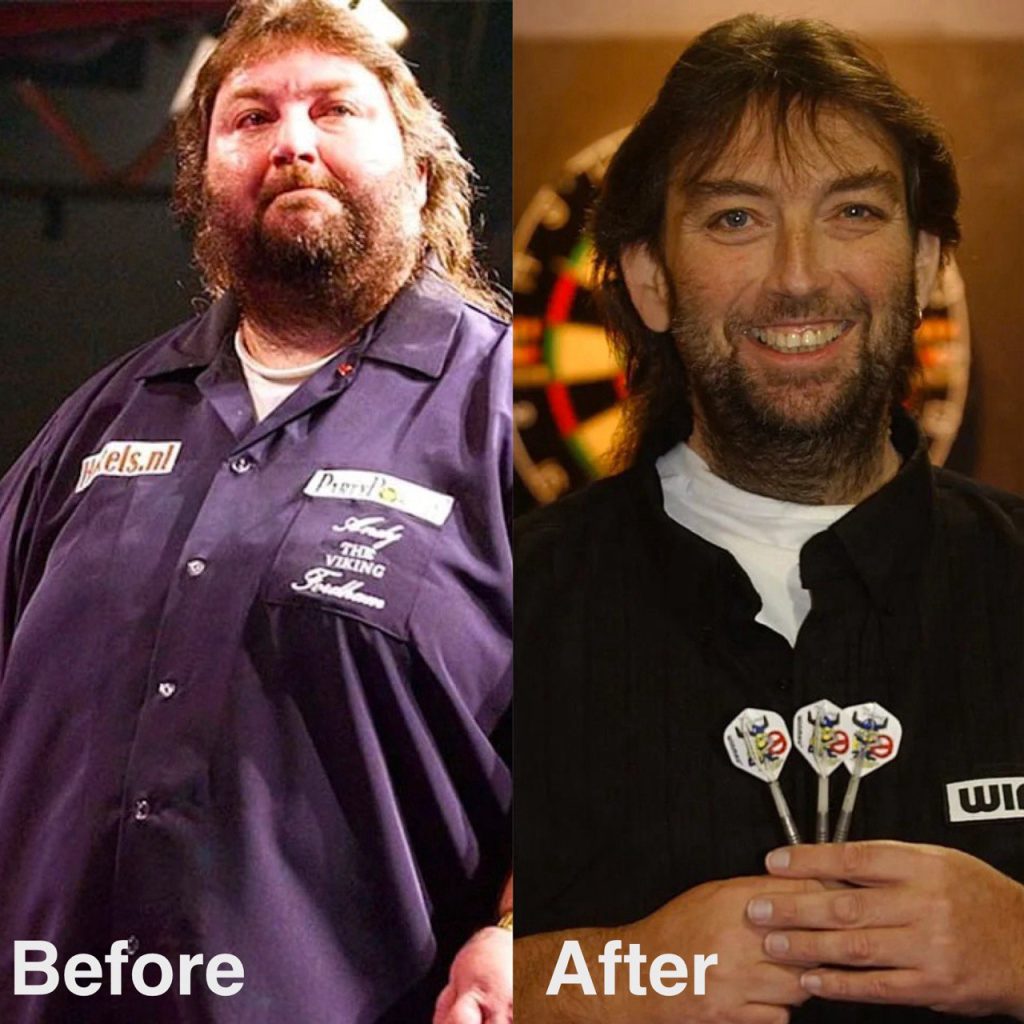Andy Fordham’s Weight Loss: The Viking’s Fight To Change
In the world of darts, one name stands out for more than his aiming skill or crowd-pleasing walk-on. Andy Fordham – nicknamed “The Viking” – earned his place in history. But his story is also a cautionary tale about health, excess and the price of success.

Early Successes and Rising Weight
Fordham came into prominence by winning the BDO World Darts Championship in 2004. At that point he weighed over 30 stone (roughly 190 kg). His appearance was imposing – long hair, big beard, large build – yet his nature was described as gentle and popular among fans and fellow players.
He admitted that his lifestyle was unhealthy: heavy drinking, takeaway food, little exercise. “On an average day I’d have up to 25 bottles of lager and half a bottle of spirits… I’d be eating badly, with take-aways and kebabs and doing no exercise.”
That combination – championship fame plus neglect of health – set the stage for what came next.
The Wake-Up Call
Fordham’s body began to speak to him. In a high-profile match against Phil Taylor in November 2004, the intensity of the lights and heat on stage contributed to him collapsing. He was forced to retire from the match.
Doctors then told him he faced real risk unless he changed. It was a blunt message. He could no longer ignore his health. He admitted he might have died if he kept going.
So, he made a decision.
The Weight Loss Effort
Fordham entered the TV programme Celebrity Fit Club. He referred to it as something he “didn’t really want to know, but … I had no choice but to do it, I would have died otherwise.”
In early 2006 he publicly noted he had lost three stone and felt noticeably better. “If I take a taxi from the pub, I’m not out of breath by the time I get into it,” he said.
By then he had cut his drinking significantly and changed diet, though he admitted the pub environment made it “hard”.
His effort is commendable. He:
- cut down alcohol drastically
- improved diet (fish, chicken, grilled items instead of take-away)
- introduced exercise such as swimming into his routine
This shows that even with a heavy build and long-term habits, change was possible – though it cost discomfort and honesty.

The Reality of Setbacks
Yet, the story did not conclude with a neat victory. Fordham later admitted that although he had got the weight down, he put a lot of it back on. In an interview he claimed he once dropped to about 16 stone after his 2007 health crisis – but then returned to about 24 stone.
In his own words: “I’ve been off the sauce for about ten years now … one doctor told me I could probably have a drink here and there but I’m one of those people who will have a couple, think it’s OK then get stupid again.”
It is perhaps uncomfortable to admit: severe change is possible, but maintaining it is often harder than the initial transformation. Fordham’s health continued to battle him – fluid in his lungs, liver damage, collapsed first-round match at world championships in 2007.
Thus his journey shows the double edge: you can climb, but the fall remains possible.
What We Can Learn – Honestly
From Fordham’s case we can draw some direct lessons. They may sound blunt – and yes, possibly uncomfortable, but they are worth stating.
- Success and excess often travel together. When Fordham won the world title, his lifestyle of alcohol and comfort followed. The limelight provided free drinks, invites, distractions. He admitted: “Maybe it was one of the worst things that could have happened to me, becoming world champion.”
- The wake-up isn’t optional. Medical warning after medical warning. Without the collapse, it is likely he would have eventually succumbed. His quote: “I watched myself growing fat in the mirror… but it was over time and I didn’t realise.”
- Losing weight is not the same as solving the root. The initial weight loss was impressive, but habits – both physical and mental – remained. As Fordham said, he is “one of those people who will have a couple, think it’s OK then get stupid again.”
- Maintenance is harder than change. He achieved big reductions but struggled to keep them off. His later weight again rose; health issues continued. It is a sober reminder: transformation is not a one-off event.
- Support and setting matter. Fordham owned a pub. He worked in an environment surrounded by alcohol and tempting food. This context made his effort more difficult. If one’s surroundings stay the same, change becomes harder.
Why This Story Matters
You might ask: why pay attention to a darts star’s weight loss journey? Because it reflects universal themes. Fame, indulgence, denial, crisis, change. Many of us may not be world champions—but many of us know the lure of comfort, the blindness to creeping weight, the need for a serious wake-up call. Fordham’s story is not just about darts. It is about us.
It is also a reminder that no one is exempt. Even someone at the top of their game, beloved by fans, can reach a point where the body demands attention. He showed humility — admitting mistakes, changing lifestyle, facing collapse. He also showed the fragility of change when the environment and mindset remain unchanged.
Final Thoughts
In the end, the weight-loss journey of Andy Fordham is neither a fairy-tale nor a cautionary tale only. It is both. It is gritty. It is real. He achieved remarkable change. He faced serious decline. He kept fighting. He sometimes failed. But he lived the truth of his choices.
If you read this and feel some discomfort – good. Change often begins with discomfort. If you feel hope – that’s valid too. Because the man known as “The Viking” showed the possibility of turning around. And he also showed that the mirror doesn’t lie – until we start listening.
Perhaps you will walk away with a question: What am I ignoring? What is creeping up slowly? What wake-up call might I need to heed?
Andy Fordham’s legacy on weight and health is messy. It is inspiring. It is sobering. It is real. And maybe, if you are honest with yourself, it might nudge you to look at your own odyssey.
